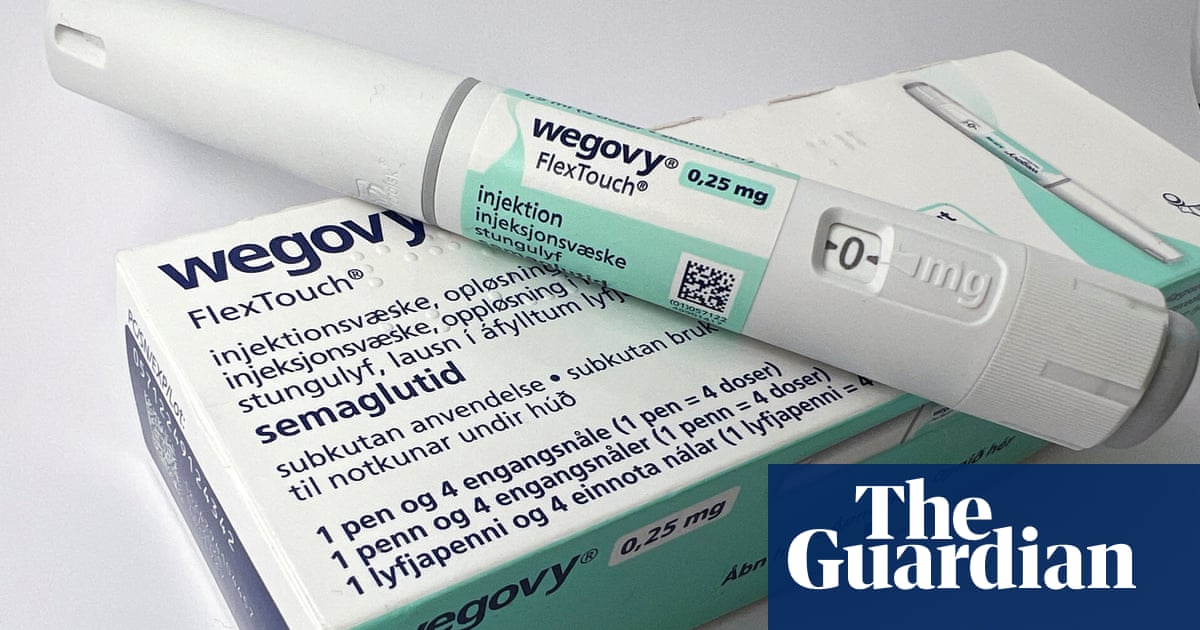
“Everyone’s on it,” says Dr Daniel Ghiyam whose “medical spa” in Ventura county, California, offers skin tightening, body contouring, vaginal rejuvenation and, lately, injections of Semaglutide, the active ingredient in a new drug called Ozempic. To hear Ghiyam tell it, these injections are Hollywood’s worst-kept secret.
“A lot of celebrities are on it,” he says. “Everyone’s who’s not talking about it is on the stuff.”
Ozempic has become so popular in the last two years because it makes people lose weight fast. It’s so controversial because of the way it works: by triggering a chemical repugnance to food itself. After being injected with Ozempic, a user could try to imagine a moist slab of black forest gateau, or a calorically-dense, half-pound Baconator bacon cheeseburger from Wendy’s, and their body physically revolts, with spasms of nausea and waves of ill feeling. It’s the chemical realization of a behavioral psychologist’s wildest dream; A Clockwork Orange for junk food, an eating disorder in an injection.
On TikTok, videos documenting Ozempic-assisted weight loss have racked up hundreds of millions of views. Elsewhere on the internet, speculation that Ozempic has catalyzed the drastic body transformations of celebrities runs wild. A number of musicians and actors told the Guardian that they personally knew high-profile people in their industries using Ozempic, although none would go on record. Ghiyam has joined in on the publicity push himself, with his own informational #OzempicWeightLoss TikToks reeling in hundreds of thousands of views.
The world’s wealthiest individual, Elon Musk, has also praised the drug, publicly and unabashedly.
Ozempic is also advertised regularly on TV: the ubiquitous commercials feature various characters who, having stabilized their blood sugar levels, are living healthy, active lives. “Oh!” they exclaim, turning to the camera, barely containing their excitement, as the soundtrack – set to the earwormy melody of Magic, the breakout 1974 single by Scottish soft-rockers Pilot – crescendos. Oh! Oh! Oh! Ozeeeeempic!
But the ad mentions weight loss only as an afterthought. In the motormouth recitation of precautions and potential side effects that underscore pharmaceutical ads, the voiceover says off-handedly “You may lose weight!” to which a chipper character responds, “Oh!”
That’s because Ozempic is not being marketed as a weight loss drug. It’s sold as a diabetes medication.
It’s gained traction in the medical community for its ability to lower blood sugar, or rein in levels of glycated hemoglobin (also known as A1C), often transforming the lives of patients.
One of its corollary effects however, is that it makes patients want to eat less. And so doctors are increasingly prescribing the drug off-label, purely for its effect helping people lose weight.
Trish Wheeler is one of thousands of Ozempic users. For years, she had exercised and eaten right. She’d even been profiled in a fitness magazine. But as she got a little older, and her body transitioned into menopause, she found her usual habits were no longer doing the trick. “Dieting was not working,” Wheeler, 53, says, “and my joints were hurting enough that I couldn’t strenuously exercise anymore”.
When the pandemic hit, the situation got even worse and, as Wheeler puts it, “the weight just piled on”. She managed to lose about 20lbs (9kg) before her doctor prescribed a new treatment: Ozempic. The treatment has seen drastic changes in Wheeler’s life: fatigue, dizziness and an elevated heart rate.
She says her brain is “running really, really slowly these days”, which makes phone calls and Zooms a little challenging. But she’s lost weight: a reported 47lbs more (21kg) . “Whether due to age or health,” Wheeler says, “traditional methods for weight loss can become less effective, and so far this drug has done a miraculous job overcoming those obstacles”.
But Ozempic is not a miracle. The drug works because Semaglutide simulates a hormone called GLP-1 that regulates blood sugar levels. If blood sugar rises, the hormone tells the body to produce more insulin, which lowers blood sugar levels in turn. This method of action has made GLP-1 a game changer in the management of type 2 diabetes, but the same hormone has also been shown to slow down the passage of food from the stomach to the small intestine, which can increase a feeling of satiety by making patients feel fuller faster.
According to data from the Mayo Clinic, studies found that patients combining weekly Semaglutide injections with healthy lifestyle changes (eating a balanced diet, exercising regularly and so on) resulted in weight loss of about 33.7lbs (15kg) in a 68-week period.
The drug’s popularity, combined with its promised results, has led to a massive run on supplies globally. The worry is that the off-label use of Ozempic for weight loss is creating shortages for people who rely on the drug in treating type 2 diabetes.
Isabelle Kenyon is a founder and CEO of Calibrate, a telehealth weight loss startup that has more than 25,000 members, all of whom are using Semaglutide for weight management.
“That’s a bad headline,” she protests when I mention a potential Semaglutide shortage. “There is no chance,” she insists, “that the use of these medications, on or off-label, is impacting the availability of these medications for diabetes”.
While Kenyon vehemently maintains that the increased usage isn’t resulting in shortages, or in diabetics being unable to access medicine, federal agencies don’t agree. They have been fretting about a Semaglutide scarcity for the past few months.
In the spring, Ozempic’s manufacturer, the Danish pharmaceutical giant Novo Nordisk, reported difficulty keeping up with the skyrocketing demand. In Australia, recommendations were made to physicians, who were instructed to prioritize Ozempic’s use in the on-label treatment of type 2 diabetes. As Australian authorities noted, “The shortage is significantly affecting people using Ozempic for its approved use.”
The US food and drug administration is sounding a similar alarm, noting that “intermittent supply disruptions” of certain quantities of Semaglutide injectables (the 0.25mg/0.5mg doses, and larger 2mg dose) are attributable to a “demand increase for the drug”. Online, some doctors say the drug is on back order through December.
Novo Nordisk responded to the uptick in off-label prescribing by introducing a new, rebranded drug, called Wegovy: a chemically identical Semaglutide injection, offered at higher doses, targeted specifically for obesity and weight management. Now, Wegovy itself is in short supply. The FDA reports that the distribution of Wegovy, in various dosages, has been temporarily paused. Wegovy’s manufacturer stopped shipments of the two smaller, starter dose strengths until their manufacturing and supply chains are able to keep pace with demand.
This pause comes at what is, arguably, an opportune time. Between the media hype, the TikTok trends, the targeted ads and the wall-to-wall blitz of TV commercials, GLP-1s seem to have exploded overnight. And while seemingly benign, the drug’s method of action – regulating blood sugar levels and promoting satiety – comes with some peculiar side effects.
Four bites of dinner and you’ve had enough
For their part, Calibrate advertises their system as a “metabolic reset … We are talking about the combination of medication and lifestyle intervention,” Kenyon explains, “to help you fundamentally reset your metabolic system in a way that sets your body up for long-term, sustained weight loss”.
“When you change your body’s insulin reaction,” Kenyon says, “you crave different food. That’s what’s happening.” As a result of this hormonal hot-wiring, certain food cravings basically vanish. The treatment is not merely mechanical, but physiological.
But not everyone thrills at those profound physiological changes.
Matt Mahowald, a veteran LA nutritionist whose A-list clients include Chris Pine, Mandy Moore and Guns N’ Roses guitarist Slash, says some patients taking GLP-1s report being nauseated by the very prospect of food itself. “They’re telling me that food is gross,” he says with a laugh. “That’s kind of the rub, right?”
Ghiyam has heard similar reports from his patients. “Patients complain to me,” he says. “‘I go to my favourite restaurant and order a steak and I take four bites and I don’t want to finish it.’ They have to run to the bathroom if they eat too much.” Both Ozempic and Wegovy name nausea and vomiting as among their most common side effects. But just as weight loss was initially a byproduct of using GLP-1s for diabetes treatment, these side effects may not be side effects at all, but the cause of the weight loss.
Simply put, Ozempic, and similar GLP-1s, may work because they make food (or at least certain types of food) taste disgusting. A 2012 paper in the journal Neuropharmacology found that this feeling of nausea was integral to reducing food take. “Whether food intake suppression,” the authors wrote, “occurs independently of nausea is unknown”. More recent research has shown that glucagon-like peptide-1 plays a key role in taste perception.
When Trish Wheeler started taking the drug, she found her physical reactions to food shifted almost immediately. “It started off making me nauseous and after eating or drinking a very small amount, I felt full,” she recalls. “If I tried to eat a few more bites it felt like everything was backing up my esophagus.” Even drinking water felt daunting, leading to a feeling of constant dehydration.
Online, forums are chock full of stories from Ozempic users whose relationship with food has changed, not only physiologically, but psychologically. “I miss enjoying food and going out to eat,” says one. Another is even more blunt, lamenting: “I hate food.”
There is, perhaps, something sinister, and even a little sci-fi, about a wildly popular weight loss treatment that works, whether in whole or in part, by making food itself disgusting.
But however weird they may seem, these kinds of chemical mechanics are not entirely uncommon. Naltrexone, an opioid antagonist prescribed to treat alcoholism, has been shown to “reduce the palatability of alcohol”, essentially making booze taste bad (or worse). The antidepressant Wellbutrin has also been long-prized for its off-label ability to make cigarettes taste disgusting, a side effect that resulted in the same chemical (bupropion) being rebranded as Zyban, an FDA-approved smoking cessation aid.
For Semaglutide’s true believers like Ghiyam, there’s nothing especially ominous about the treatments. “You can still enjoy [your favorite foods],” he says. “But you enjoy four bites, fives bites, and you’re good.” Ghiyam also stresses that these spells of intense aversion will pass in time, as patients are “trained” to eat healthier foods. In due course of treatment, the desire or stimulus itself is exterminated – “beyond the zero”, as Pavlov famously put it in his 1927 lecture on the conditioned reflexes of dogs.
The panacea for the obesity crisis?
Such treatments may seem a little drastic. But as Calibrate’s CEO Isabelle Kenyon and chief medical officer Kim Boyd argue, they’re merited given the scale and severity of America’s obesity epidemic. More than 40% of Americans qualify as obese, which puts them at increased risk for heart disease, stroke and type 2 diabetes.
In 2013, the American Medical Association officially voted to declare obesity a disease, which demands both treatment and prevention efforts. The decision came after decades of debate, regarding whether obesity was a proper disease, or merely a behavioral issue, or a “lifestyle choice”.
Despite the official declaration, and resulting changes in treatment protocols, the idea that being overweight is somehow a moral failing lingers in the culture. Some insurers have also denied coverage for GLP-1s, maintaining that weight loss treatments are a form “vanity”. “Is obesity a medical condition that warrants treatment, or some sort of willpower issue?” Boyd asks, rhetorically. “We fundamentally believe that it is a medical issue that warrants treatment.”
Desperate times may well call for desperate measures. But not everyone sees Ozempic (or Wegovy, or similar drugs) as some magical, miracle intervention into the obesity epidemic. But this miracle comes with its own costs, both medical and cultural.
Among the less common side effects are hair loss, heartburn and swelling at the site of injection. Others are even more severe. Animal studies have linked Semaglutide to an increased risk for thyroid cancers, as well as pancreatitis and gallstones. (Some law firms already seem to be gearing up to file suits on the basis of these adverse effects.) The drug’s defenders would argue that such risks are acceptable, given the wide range of dangers associated with obesity: heart disease, stroke, sleep apnea, cancer, osteoarthritis and, of course, type 2 diabetes.
The broader cultural implications of injecting Semaglutide for weight loss are themselves wide-ranging. The link between obesity (or fitness) and “lifestyle” is tough to shake, despite the latest recommendations of doctors and medical authorities. Losing weight is typically regarded as an accomplishment: the result of hard work, dedication and tremendous self-discipline. (Such attitudes, which equate body weight to some sense of morality, may only work to reinforce the psychological bases of some eating disorders.) Does one show off their swollen injection site, as they might a newly sculpted six-pack of abdominal muscles? Does it make sense to congratulate someone for dropping 30lbs from taking Semaglutide? And what if they’re doing so at the expense of putting people who may be more in need of the drug – such as type 2 diabetics – at further risk?
Hollywood nutritionist Mahowald warns that these trendy treatments can work to distract from deeper problems in the American diet, which begin at the level of agriculture, and the foods fed to cattle. (“It’s hard to eat well,” he says, understating the case.) The drug’s effect on calorie intake, he also notes, may also hamper some long-term health goals, as some patients may not be taking in enough calories to exercise intensely and to build (and maintain) muscle. While telehealth prescribers like Calibrate stress that GLP-1s are part of a more holistic treatment involving diet, exercise and lifestyle change, Mahowald is concerned that these treatments are becoming “more of a substitute for a healthy eating plan”.
Such sober thinking hardly predominates in Hollywood, where Semaglutide injections are increasingly the subject of gossipy speculation. Their predominance also remains something of an open secret, as stigmas and outmoded thinking about obesity prevail. Culturally, such treatments can still seem like a shortcut, or chemical cheat code. Nobody goes on Oprah to brag about getting liposuction, or having their stomach stapled, or injecting themselves weekly with 2mg of prescription glucagon-like peptide-1 receptor agonists. While aspiring TikTok tastemakers may get plenty of views broadcasting their “Ozempic journey”, higher-ups in the influencer economy remain tight-lipped.
“Some people just don’t want to talk about it,” says Ghiyam. “It’s the same reason somebody doesn’t tell you when they had a facelift or had any other work done. ‘No! I just look 30 years younger naturally, all of a sudden! I never had botox!’ They don’t want people to think that.”
Singers, actors and reality TV stars celebrated for their miraculous body transformations who may be taking the injections may well never cop to it. But for regular users who aren’t subject to tabloid scrutiny, Ozempic is nothing to be ashamed about. “I tell everyone who asks about my weight loss how it was accomplished,” says Trish Wheeler. “No one has acted as if they thought I was cheating. They mostly want to know where they can line up and get some for themselves.”












